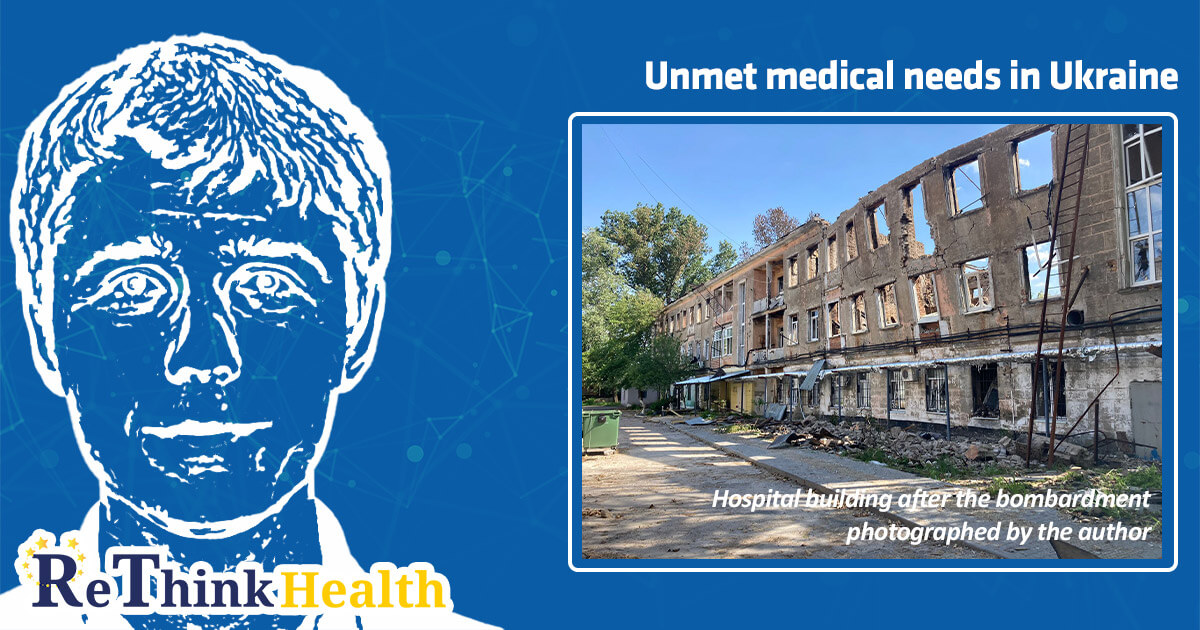When talking about unmet medical needs, here in Ukraine we were used to highlighting morbidity structure, issues of medical reform, the establishment of patients’ registries, etc. These questions are really pressing and require close attention from healthcare authorities, as they have the potential to influence significantly the population’s health. However, since the full-scale military invasion of the Russian Federation to Ukraine, the priorities in Ukrainian healthcare have shifted. In the present piece, we will try to highlight the most painful, in our point of view, unmet demands of the Ukrainian healthcare system.
1. Assessment of the needs in healthcare
Currently, there is not much known about the condition of Ukrainian healthcare. A medical reform, which started in 2016, impacted the surveillance tools for many diseases. The transition to the new tools for the biggest part of the diseases has not happened yet. Additionally, the COVID-19 pandemic dragged away the focus from the completion of the reform and disrupted the proper functioning of multiple levels of healthcare. Therefore, it is difficult to assess the dynamics of the pre-invasion morbidity structure and what has changed afterward. Attempts to evaluate the current situation are being performed, but they are not as numerous as they could be in a peaceful time. Despite the ongoing war leading to the prioritization of more urgent needs, planning for the further development of the system should remain in focus.
2. Healthcare services coverage
As of 24th July 2022, more than 900 healthcare facilities in Ukraine were damaged, and 127 hospitals were destroyed. As of April 2023, large territories of Ukraine were de-occupied. But, nevertheless, continuous shelling and rocket strikes continue to damage Ukrainian infrastructure, including healthcare facilities. Inner migration of the population and increased demand for medical care of wounded in combat militaries and civilians cause a strong strain on the preserved part of the healthcare system. In rural areas, especially in regions that have spent some time under Russian occupation, there is a severe lack of healthcare personnel and medical goods supply. Multiple non-governmental organizations with their humanitarian missions make a huge difference. However, a systematic approach and careful planning are needed to address the current situation.
3. Cancer care
Pre-invasion cancer epidemiology in Ukraine was quite comparable to the world’s data. Despite the comparison with the data from European Region revealing the need for improvement in cancer care (Semenov et al.), implementation of nationwide programs would be likely to improve the situation. However, the priority of cancer care was pushed back during the COVID-19 pandemic, as well as during the war. It is natural to expect a surge of cancer cases, especially in advanced stages, given that the information about these cases will be accumulated.
4. Mental health
Mental health problems were under-recognized in Ukraine before the full-scale invasion. The comprehensive epidemiological data about mental health problems in the Ukrainian population was quite scarce. On the one hand, the stigma of mental health and the cultural perception that mental health issues are not serious problems (unlike somatic pathologies) could be an important cause of neglecting mental health by people. On the other hand, treatment of mental health conditions is usually prolonged and costly (like antidepressants, which are not reimbursed in Ukraine, or psychotherapy). It is quite natural to expect a drastic surge in the number of people who require psychological support during the war.
It is expected that around 15 million Ukrainians will require psychological support, among them around 3-4 million will require pharmacological treatment due to mental health problems. Importantly, mental disorders often aggravate pre-existing pathology or could be a risk factor for the development of new diseases, which for sure will influence the population’s health.
5. Rehabilitation
Last but not least, are the consequences of the direct influence of combat and artillery/rocket strikes. It is expected that the number of people who need rehabilitation and prosthetics will increase in the nearest time because of the war. The official information about the number of wounded and killed in combat (both military and civilians) is scarce, and contradictory, and usually comes with a delay. However, given the intensity of combat, the area involved, and the numbers that appear in the media, it can be assumed that the genuine number of wounded people is huge.
It is very likely that Ukrainian rehabilitation centers will face a need for restructuring and an increase in their capabilities. A lot of Ukrainian soldiers and civilians receive medical help in other countries and it makes a huge difference. But the increase of resources in Ukrainian own rehabilitation centers might become a pressing question in Ukrainian healthcare.

The presented list is not exhaustive. There are other aspects of Ukrainian healthcare that require attention, such as the shift from emergency care to planned healthcare programs, dealing with an energy shortage due to Russian attacks on the Ukrainian energy systems, training of medical staff to face the challenges related to the war, and many others.
The text was prepared by Viktor V. Semenov and Lilia V. Kriachkova in cooperation with the Centre for Innovation in Medicine.
